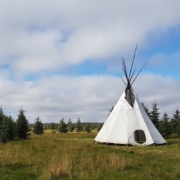Co-PI Update – Danika Billie Littlechild

Tansi Everyone! Greetings!
Welcome to the weekly Ărramăt Project Update.
Since the inception of our project, through the first application and submission of the LOI and onward, the Co-PI Team have endeavoured to keep everyone we engage in the project informed and up to date on our progress. This has not always been easy, as we are slowly building the internal infrastructure of our project with the active and on-going contributions of everyone on our larger team.
As many of you know, we submitted our Letter of Intent (LOI) for the New Frontiers in Research Fund Transformation Funding Opportunity. This is an opportunity offered through the Tri-agency Institutional Programs Secretariat, which is housed within the Social Sciences and Humanities Research Council (SSHRC), on behalf of Canada’s three research granting agencies: the Canadian Institutes of Health Research (CIHR), the Natural Sciences and Engineering Research Council (NSERC) and SSHRC. At the time of submission, we had 17 Co-Applicants and 47 Collaborators.
We think the Ărramăt Project is important in three ways:
- Build the capacity of Indigenous organizations to document, share and use their knowledge about the interconnections between biodiversity conservation and health & well-being;
- Support community-based participatory research (Indigenous-led research projects) that evidence the health and well-being outcomes of biodiversity conservation;
- Support Indigenous leaders in driving institutional change at local, regional, and global scales to improve health and well-being, and curb the decline of biodiversity.
Out of hundreds of applications, the Ărramăt Project was selected amongst a handful of others to proceed to the second stage of the application.
Our application was found to be very strong in terms of the inclusion of Indigenous communities and interdisciplinarity. We were urged to explore and highlight the potential impacts of our research on science, biodiversity conservation, and potential underlying colonial narratives. More importantly, we were asked to provide greater detail about the range of sub-projects and related research activities with our various partners globally. The reviewers of our application want to understand how we are coordinating multiple places and peoples in the context of our proposed work. They want us to demonstrate how our research will be relevant for policymakers, to other communities, and the potential impacts in ecological restoration and other areas. The reviewers would like to see how the results of our research will be shared with other communities beyond those engaged in the project.
In recent weeks, we have presented the “Tipi Model” approach as a methodology of project governance that is founded in a specific Cree approach using the Tipi as a template for the organization, decision making, and coordination. We hope that the specificity of this approach will open the doors for all our Indigenous Partners to be similarly specific and self-determining in their prospective activities with the Ărramăt Project. We also heard many members of our broader team urging us to highlight a place-based approach to our research strategies and agendas. We as a Co-PI Team are committed to reflecting what we hear from our partners, co-applicants, and collaborators in the next iteration of our application. This second stage of the NFRF-Transformation application needs to be completed by March 26th at the latest.
As members of our larger team, you have been actively contributing to the formation of this second stage application in a number of ways. Primarily, a great many of you have participated in our Webinar Series, either as listeners/witnesses or as knowledge holders and expert presenters. Various members of our Co-PI Team have also been in touch with many of you through phone calls, emails, and individual/organizational meetings.
So far, we have heard presentations on topics ranging from global health, human rights and food security; Indigenous health through conservation-development; cultural landscapes; traditional medicines; the legal personality of landscape features; traditional agriculture and biodiversity management; communities, conservation & livelihoods; and Indigenous re-wilding as a means to realize well-being. In coming weeks, we will hear from presenters within the Arramat team on our backyard medicine cabinet; Indigenous methodologies of knowledge; weaving ways of knowing in wildlife ecology; and Indigenous fisheries science, amongst many more! You can access these recorded webinars right here on our new, secure website.
You have also been asked to identify the toolbox areas you are most interested in being affiliated with, given the best/wise practices from your area of study or work, which will result in the formation of Working Groups. These Working Groups will facilitate the most efficient engagement of your expertise in assisting us to finalize the next stage of our application.
For our Indigenous Partners, we asked that you provide us with your preferred terminologies of self-identification, as well as your Indigenous place name for where you are from so that we are not privileging colonial place/community names and constructs. If you are comfortable with this, we will be excited to make this Indigenous self-identification a significant element of how we describe our partners. If you are not comfortable with providing this information, we will use the identifying names and place names that you have already provided us. This may result in you being identified in relation to a particular nation-state (ie. Canada), city/municipality, region, or community as described in your communications. Please be sure to take a few moments to provide us with your Indigenous names/place names if possible.
We look forward to working with all of you intensively over the coming weeks. Please do not hesitate to reach out to any of us as lead co-PIs for additional information or discussion.
Hai Hai, With Gratitude,
Danika Billie Littlechild

 © Tracy Howlett
© Tracy Howlett
 © Tracy Howlett
© Tracy Howlett